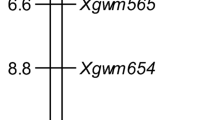Abstract
Investigations were carried out to determine the nature and number of genes governing apical lethality (apical death) in a number of intervarietal crosses of wheat. Genetic analysis of data in segregating generations of the cross WR95/HW2041 and its reciprocal cross revealed that WR95 carries a recessive gene that leads to the death of certain individuals when combined with another recessive gene derived from HW2041. The phenomenon, which is denoted here as “apical lethality”, is controlled by two complementary recessive genes coming together from two different parents in certain F2 individuals. The gene symbols apd 1 in WR95 and apd 2 in HW2041 are proposed for these genes of apical lethality, respectively. Uniculms observed in the F2 generation are heterozygous (apd 1 apd 1 Apd 2 apd 2) and, therefore, the uniculmness trait does not breed true. Of the wheat genotypes tested, the gene apd 2 was found to be present in CL983, CL1019, Lok-1, HW2041, HD2329, HW2011, WH147, HW2042, HW2047, WR196, WR544, WR798 and WR936, while the remaining genotypes, including some of the exotics such as Atila, carried both Apd 1 and Apd 2 in the homozygous condition.


Similar content being viewed by others
References
Atsmon D, Jacob E (1977) A newly bred “Gigas” form of bread wheat (Triticum aestivum L.): morphological features and thermo-photoperiodic responses. Crop Sci 17:31–35
Atsmon D, Bush MG, Evans LT (1986) Effects of environmental conditions on expression of the Gigas characters in wheat. Aust J Plant Physiol 13:365–379
Caldwell RM, Compton LE (1943) Complementary lethal genes in wheat. J Hered 34:67–70
Christopher BA, Atsmon D, Feldman M (1985) Mode of inheritance and chromosomal allocation of stunting genes in common wheat. Crop Sci 25:147–151
Hermsen JGT (1966) Hybrid necrosis and red hybrid chlorosis. In: Proc 2nd Int Wheat Genet Symp. Hereditas [Suppl 2]:439–452
Hermsen JGT (1967) Hybrid dwarfness in wheat. Euphytica 16:134–162
Inbal E (1982) Morpho-genetic, genetic and physiological aspects of stunting expression in wheat (Triticum aestivum L.). PhD thesis, Department of Plant Genetics, Weizmann Institute of Science, Rehovot, Israel
McIntosh RA (1983) Catalogue of gene symbols for wheat. Annu Wheat Newsl 29[Suppl]:170–172
Moore K (1969) The genetical control of the grass dwarf phenotype in Triticum aestivum L. Euphytica 18:190–203
Tsunewaki K (1966) Gene analysis on chlorosis of the hybrid, Triticum aestivum var. Chinese Spring × T. macha var. subletschumicum and its bearing on the genetic basis of necrosis and chlorosis. Jpn J Genet 41:413–426
Worland AJ, Law CN (1980) The genetics of hybrid dwarfing in wheat. Z Pflanzenzuecht 85:28–39
Author information
Authors and Affiliations
Corresponding author
Rights and permissions
About this article
Cite this article
Tomar, S.M.S., Vinod & Singh, B. Genetic analysis of apical lethality in Triticum aestivum L.. Euphytica 156, 425–431 (2007). https://doi.org/10.1007/s10681-007-9392-8
Received:
Accepted:
Published:
Issue Date:
DOI: https://doi.org/10.1007/s10681-007-9392-8



